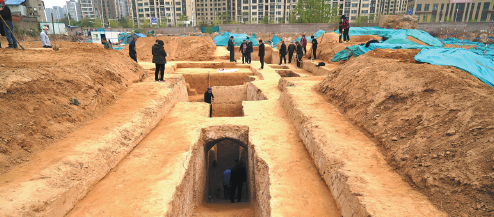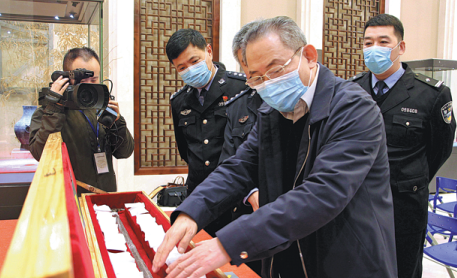Relics protection efforts deliver results
Tough punishment handed out for offenses involving treasured items
Li Jie is working to protect cultural relics after retiring from her job at an antiques shop in Xi'an, capital of Shaanxi province, early this year.
With a deep affection for the city, which was the political, economic and cultural center of several Chinese dynasties, the 55-year-old is now a volunteer responsible for providing information to law enforcement departments about damage caused to cultural relics.
After hearing that tomb robbers had been severely punished in Hangzhou, capital of Zhejiang province, last month, Li praised the increased legal protection for such relics, but she could not hide her anger and sadness about the damage caused to the historical site.
On Oct 12, Hangzhou Intermediate People's Court sentenced Jiang Minglei and Li Changwei to life imprisonment for excavating and stealing a large number of precious relics from the tomb of Qian Liu, the founder and first ruler of the Wuyue Kingdom (907-978), who was born and buried in Lin'an, Hangzhou.
The court ordered the confiscation of Jiang and Li's personal property and the recovery of their illicit gains.
In June 2001, the State Council, China's Cabinet, announced that the mausoleum site of the Wuyue Kingdom, including the king's tomb, was among the fifth batch of key cultural relics to be placed under national protection.
According to the Hangzhou court, the two defendants selected the tomb online as a robbery target in April 2019. A month later, they traveled to Hangzhou from Fujian province, rented a house in Lin'an and bought tools to raid the tomb. A few days after excavating it, they were captured by police.
The court said the tomb has great historical, artistic and scientific value, but added that although Jiang and Li confessed to their crimes, and the relics were recovered by police, the defendants could not be treated leniently.
Under the Criminal Law, anyone robbing tombs that are under national protection, or seriously damaging heritage, faces a sentence of up to life imprisonment.
Li Jie said, "Tomb robbers deserve tough punishment, as they not only damage historical objects but also the original appearance of a grave, which may have significant value."
Stronger fight
As interest in cultural relics increases across China, some offenders, driven by the huge illegal profits to be made, have started to excavate, steal, resell and smuggle cultural relics, according to the Ministry of Public Security.
In May, for example, police in Jiangsu province captured a total of 30 tomb robbers and people reselling such relics, recovering more than 1,500 stolen items, the ministry said.
In August last year, the ministry and the National Cultural Heritage Administration launched a oneyear nationwide campaign against crimes involving cultural relics, focusing on thefts of stone carvings from grottoes, looting of ancient cultural sites and tombs, and thefts from ancient pagodas.
Data from the campaign show that police across the country achieved remarkable results in combating the theft of antiquities, with some 2,200 cases solved, 4,500 suspects arrested and about 58,000 items recovered by the end of August this year.
The ministry said the number of crimes involving such items last year fell to the lowest level since 2013, showing just how effective the campaign had been.
Chinese courts and procuratorates have also attached greater importance to protecting historical sites in recent years to ensure the safety of relics.
For instance, prosecutors nationwide have played a bigger supervisory role by bringing public interest litigation against government agencies that have not performed well in protecting relics.
Joint efforts
While combating crimes involving relics, the Ministry of Public Security has also strengthened prevention and security work at museums and heritage sites with local authorities and pledged to conduct joint patrols to eliminate potential safety hazards.
Fu Yong, a police officer from Chengdu, capital of Sichuan province, highlighted the significance of joint efforts in protecting relics, as some stolen items are sometimes transferred or bought in antique markets, rather than being found at crime scenes.
He called for people from more walks of life to promptly report irregularities involving relics to public security authorities and to help reduce the risk of further thefts.
Yang Honggang is just the type of person Fu is looking for, as the 60-year-old has devoted most of his time and energy for the past 40 years to protecting cultural heritage in Xi'an.
Nicknamed "the guardian of cultural relics", he patrols the city to detect suspected offenses involving such items, before passing the details to heritage authorities or to public security departments for further investigation.
Over the past four decades, he has coordinated with local government agencies in dealing with 510 administrative cases and has helped local police solve 56 criminal cases. Yang has also helped the authorities demolish more than 50,000 square meters of illegal buildings in cultural relic protection areas.
"It's never an easy job, as it involves inspecting fields in the countryside and areas where there are no regular public transportation services, because historical sites and graves are often located in these places," Yang said.
"We never stop our patrols, even on exceptionally humid days, in rainstorms or heavy snow. When other families reunite or enjoy holidays, I need to visit sites to inspect them. Enduring loneliness and hardship is all part of my work."
He added that such downsides are nothing compared with the sense of achievement that comes from solving cases and protecting relics.
Li, the volunteer, often provides Yang with suggestions about protection measures. Comparing herself to a tentacle of his, she said, "The more tentacles, the better (for cultural heritage conservation)."
If the pair need a professional opinion on whether unearthed items are relics, they usually turn to Feng Jian, head of the Xi'an Academy of Archaeology and Cultural Relics Protection, to carry out additional identification work.
Praising the joint efforts made to protect cultural relics in the city, Feng suggested such work be expanded nationwide.
Gratitude, responsibility
Feng said he is glad to see China placing priority on the protection and development of cultural relics in the 14th Five-Year Plan (2021-25), adding that more efforts should be made concerning the use of technology and cultivation of talent.
The plan states that archaeological research must be carried out before land is transferred for major urban construction work, in order to balance heritage protection and economic development.
A national registration system for cultural relics will also be launched to ensure their safety.
Feng said, "Protecting historical and cultural sites has never been a job for archaeologists. Instead, it's a social responsibility for everyone."
Li Jie said: "We should be grateful to Xi'an, as we are benefiting from the city's rich historical and cultural relics."
 |
|
This Tang Dynasty (618-907) tomb in Zhengzhou, Henan province, is believed to have been robbed many times before the Yuan Dynasty (1271-1368) HAN ZHANGYUN/CHINA NEWS SERVICE |
 |
|
Zheng Tongxiu, curator of the Shandong Museum, displays relics seized by police. ZHAO XIAO/CHINA NEWS SERVICE |
 |
|
Visitors line up to enter an exhibition in Chengdu, Sichuan province, featuring the book The Grave Robbers' Chronicles. YUAN KEJIA/FOR CHINA DAILY |









